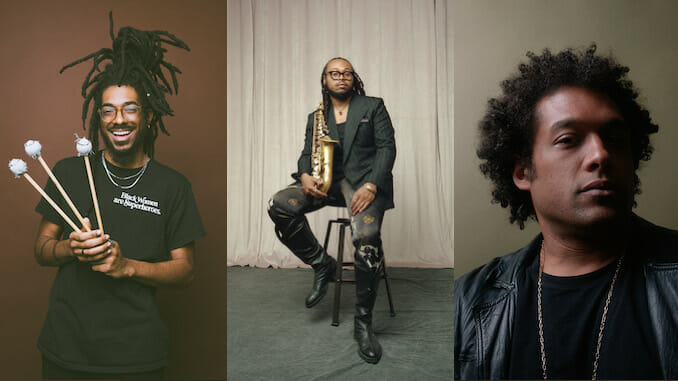At Montreal Jazz Festival, a New Generation of Jazz Masters Takes the Stage
Photos by Lauren Desberg, Rog Walker, Sulyiman Stokes
Those who were once the Young Lions of jazz are now the old cats—hep cats, perhaps, but old just the same. Wynton Marsalis, the public face of the Young Lions movement in the 1980s and 1990s, is now 60. He seems to recognize his altered position, for when he led the Jazz at Lincoln Center Orchestra at this year’s Montreal Jazz Festival, he made a point to tell the audience that the 15-piece ensemble included three recent college graduates.
“And Immanuel Wilkins,” Marsalis added, “is someone else you need to pay attention to. He’s playing somewhere at this festival.”
Wilkins, only 24, performed three times in Montreal: twice leading his own quartet and once playing in drummer Makaya McCraven’s group. The alto saxophonist provided some of the most thrilling music of the festival, technically accomplished enough to get Marsalis’ stamp of approval, but also free and wild enough to thrive in McCraven’s boundary-pushing free improvisations. He’s a central figure in the new generation about to remake jazz as profoundly as Marsalis and his comrades did at the end of the last century.
Wilkins and McCraven joined four other bandleaders from this new movement at the Montreal Festival: trumpeters Christian Scott aTunde Adjuah and Marquis Hill, vibraphonist Joel Ross and vocalist Cécile McLorin Salvant. These six musicians, all under the age of 40, are no longer promising youngsters starting out on their careers; they are at a stage where they are fulfilling that promise and emerging as mature, major artists in the genre.
Like Wilkins, they are all technically accomplished, able to exert precision control over pitch, time and dynamics. Unlike some of their predecessors, though, this new generation uses that virtuosity as a license to test limits, not as an excuse to erect fences around “real jazz.” This new movement grew up in the hip-hop era and in the Black church, and they can command both vocabularies when it suits their purposes, but they are just as willing to venture into the disorienting realms of avant-garde jazz. They are fashioning an unprecedented synthesis.
And for us in the audience, those mechanical skills make us more comfortable during their most daring escapades. Because we know that every note choice is intentional and accurate, we can trust that the artistic logic will reveal itself. And when it does—even far beyond the boundary of the familiar and expected—that can be thrilling.
On the festival’s opening day, June 30, McCraven led a quartet that included Wilkins, Hill and electric bassist Junius Paul at a downtown Catholic Church called Gesu. The drummer/leader is a big man who wears a gold medallion over black T-shirts and sports an expansive afro. He possesses not only the physical power to play fast and loud across the entire drum kit, but also the skill to land every hit in the right place. He can perfectly replicate a hip-hop drum loop or the rousing march of a church processional.
On this occasion, however, he opened the door to free improvisation. At first, there was a lot of groping in the form of rattling percussion and squeaking horns, but Hill settled on a catchy two-bar theme. He repeated it so emphatically that Wilkins added a harmony on top, Paul on the bottom, and the motif shape-shifted till Wilkins was wailing ecstatically over McCraven’s rampaging drums.
Later that evening, a short walk away, Wilkins reunited with his regular quartet (pianist Micah Thomas, bassist Daryl Johns and drummer Kweku Sumbry) in a public park for one of the festival’s free concerts. With a neon sculpture in the shape of a playground jungle gym flashing red and blue behind them, the quartet focused on their latest release, The 7th Hand, one of this year’s very best albums.
These seven new compositions from Wilkins are rooted in the church, and the saxophonist captures that sense of devotion and inquiry with an attentiveness and curiosity that are the best sides of religion. But this is not a music of simple questions and simple answers; these are instrumentals as complicated as the world outside the sanctuary, where faith and doubt go to the mat in a wrestling match.
In Montreal, the foursome translated that studio tension into live drama, not by playing loud and fast, but by creating a patient, transparent atmosphere where each nuanced shift of accent or tone could register. With his thin braids falling to his waist, his dark-frame glasses sliding down his nose and his gold-and-black coat hanging open, Wilkins relied on understatement, allowing the resonant tone and punctuating pauses of his alto sax to tell the story.
-

-

-

-

-

-

-

-

-

-

-

-

-

-

-

-

-

-

-

-

-

-

-

-

-

-

-

-

-

-

-

-

-

-

-

-

-

-

-

-








































